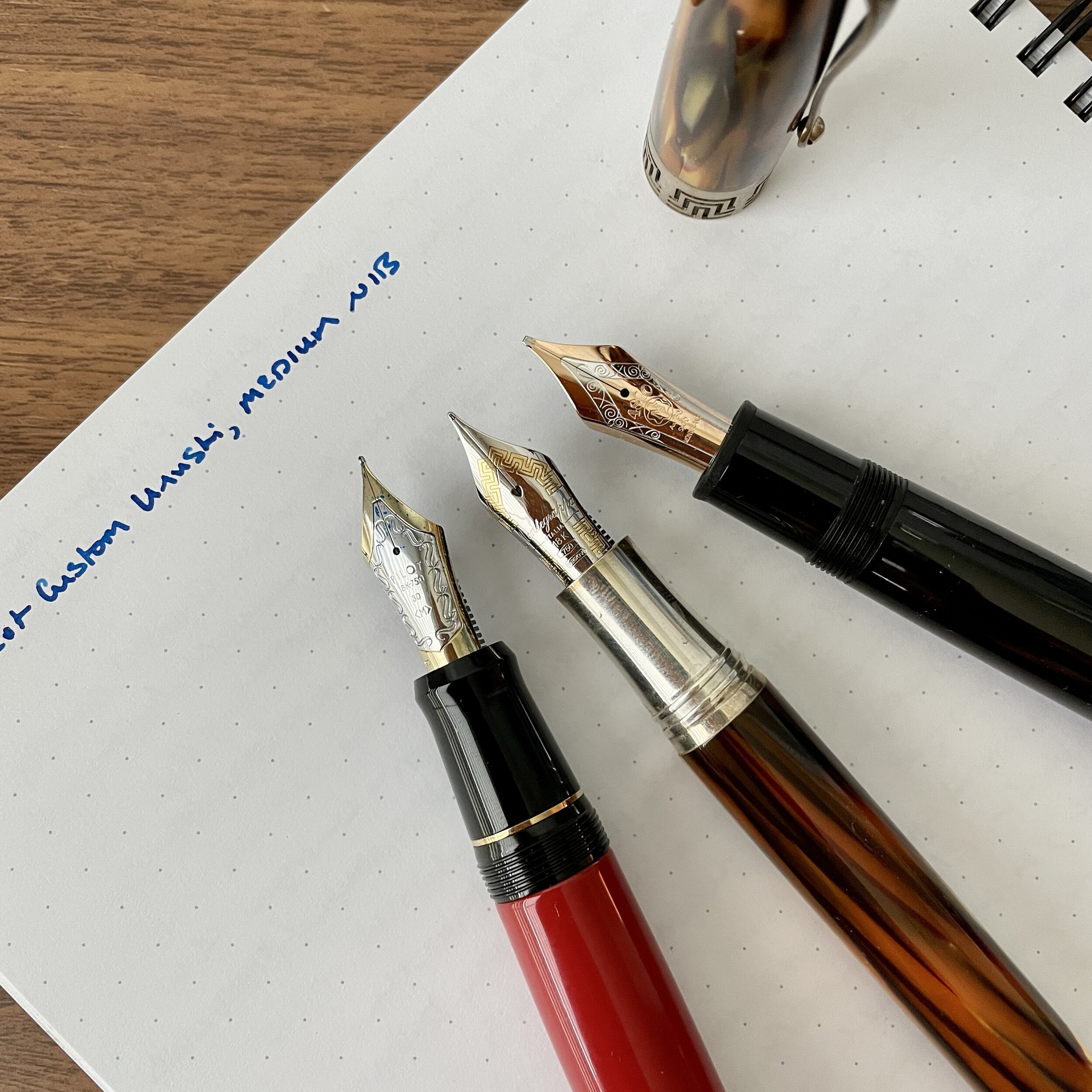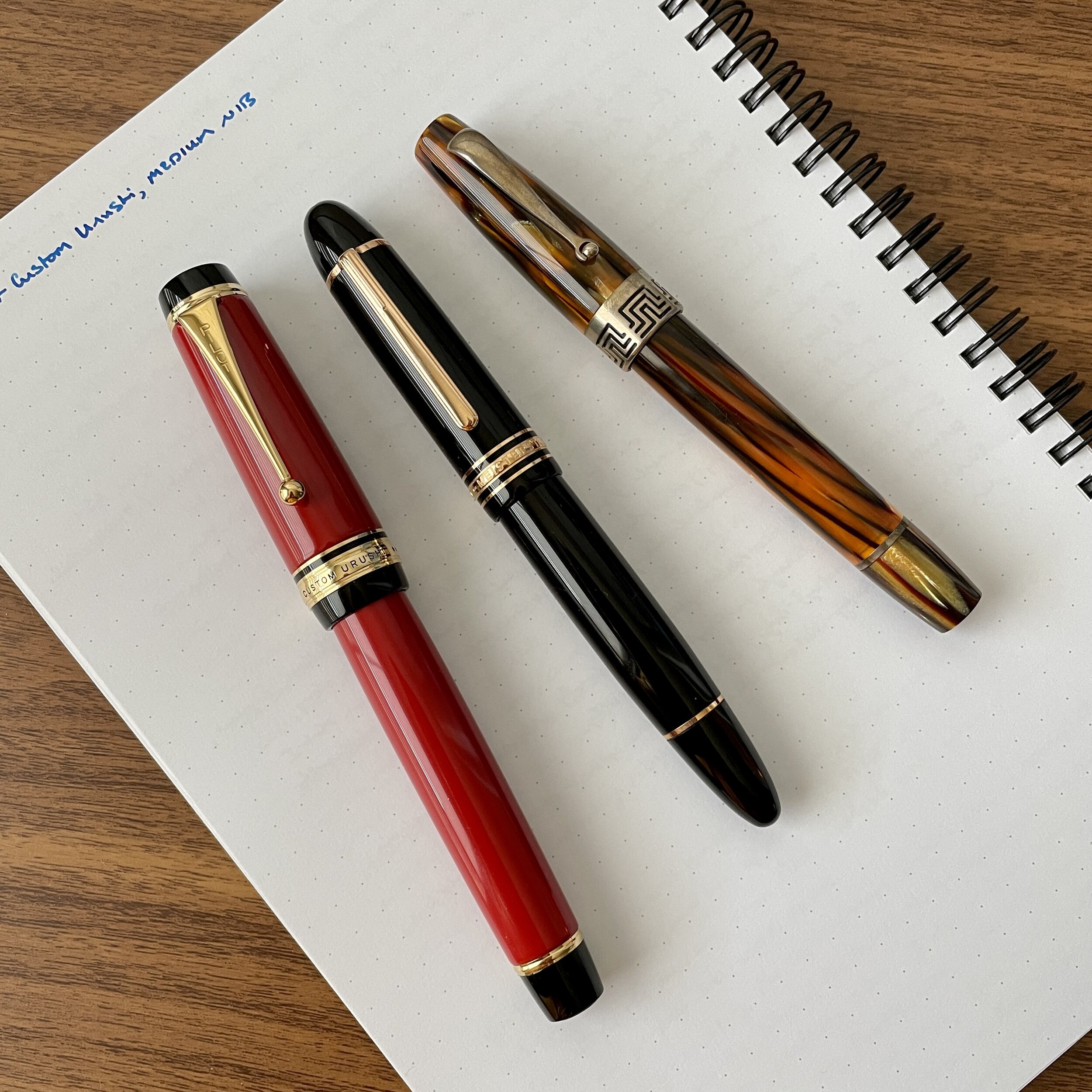I’ve been working my way back through the lower-priced tiers of Platinum fountain pens in recent weeks, from the newer Prefounte to the old standbys like the Platinum Plaisir and the Platinum Preppy. I have to say - Platinum absolutely rules the $5-20 price point, with very few pen companies offering the same level of choice and consistent quality. As I’ll discuss more today, Platinum has even opened up the entry-level price segment to the limited edition game, allowing new and price-conscious enthusiasts to explore special releases and things like Japanese Maki-e style finishes that otherwise would be cost-prohibitive to many.
My two favorite patterns from this year's Preppy Wa release: Koi no Taki-Nobori (Carp Climbing a Waterfall), left, and Yanagi ni Kournori (Bats and Willow), right. Both pens feature silver and gold screened artwork, respectively, over a dark blue-black/blue-green base.
I decided to review Platinum’s Preppy Wa, Modern Maki-e Series 2, because this weekend is the San Francisco Pen Show and, well, that show can be a very expensive proposition. It’s known for hosting a large number of vendors focused on high-end Japanese pens, both modern and vintage, including pens with specialized urushi lacquerwork and Maki-e designs. I’ve never delved deeply into that area, mainly because I don’t feel that I know enough about it to fully appreciate the art, making it difficult to justify laying out $1,000 or more for a high-end finished piece. I do, however, genuinely enjoy the intricate designs and overall look of this style of artwork, which is one reason I’ve become such an enthusiastic supporter of what Platinum has done with the Preppy Wa.
At first, I scratched my head when I saw that Platinum had decided to introduce a “modern Maki-e” special edition to the Preppy lineup. A limited edition version of a $5 pen? With Maki-e? After seeing the first series, however, I knew that Platinum probably had a hit on their hands and that going forward, we’d all be awaiting each year’s release. How did they do this and keep the price point so low? Well, “modern Maki-e” uses a different technique from traditional Maki-e, which allows it to be produced in larger quantities. According to Platinum:
“Unlike conventional Maki-e, it is applied with silk screen printing instead of urushi lacquer on the underlayer, which is then sprinkled with colored powders such as gold and silver and hand-finished one by one by Maki-e artisans. It gives more thickness compared to normal printing, while the reflections and shades of the powders create a three-dimensional feel.”
The gold and silver powders used in the "maki-e style" artwork really does sparkle, and the texture feels nice in the hand. Shown here with the matte black Platinum Plaisir.
This process results in an extremely nice pen for the price point. While it is a Preppy, and therefore won’t last forever, the designs on the pens in my own collection have proven durable without any real discernible wear. Each modern Maki-e collection features six “traditional and elegant Japanese patterns,” and Platinum has provided a short description of the meaning behind each. For example, the two pens shown here are:
Koi no Taki-Nobori (“Carp climbing up a waterfall”): “Carp with strong vitality is considered the chief river fish. And it is also said to be an auspicious pattern that symbolizes success in life, based on an ancient Chinese story that says ‘A carp that climbs a rushing waterfall ascends to the sky and becomes a dragon.’”
Yanagi ni Kournouri (“Bats and Willow): “In China, the kanji for bat has the same sound as ‘turning into good fortune,’ so it is considered an auspicious pattern that symbolizes good fortune and longevity. Japan was also influenced by this and was seen as a symbol of happiness during the Heian period.”
So a history lesson with your pens? Always fun! Plus, I’m a big believer in usable, functional artwork. You shouldn’t hesitate to use a pen like a Platinum Preppy in your everyday life, especially where even the limited edition costs only $13, and Platinum’s excellent stainless steel nibs and slip-and-seal cap system have long been regarded as low-cost workhorses that write reliably whenever you need them. These pens are versatile - many people add an o-ring or silicone grease to the threads and fill them as eyedroppers - but I prefer to use my Preppy fountain pens as cartridge pens for simplicity and because I tend to use them when I travel. Just keep in mind that Platinum uses proprietary cartridges and converters.
The Platinum Preppy, Prefounte, and Plaisir fountain pens all use the same steel nib. In my experience, Preppys tend to hold up well but eventually you might see cracks form on the plastic clip and around the lip of the cap. The caps on the Preppy Wa pens are clear, meaning they can be replaced if you want to keep your special barrel.
Takeaways and Where to Buy
The Platinum Preppy remains a go-to recommendation for beginners and enthusiasts alike, and the Preppy Wa series is a fun upgrade to the standard Preppy. Personally, I’ve enjoyed both “Modern Maki-e” series more than the original Preppy Wa, and of the six screen-printed designs, most people will be able to find one that appeals to them. If I were forced to pick a favorite, it would be the Koi no-Taki-Nobori (Carp Climbing the Waterfall), though I also appreciate the darker tones in the Yanagi ni Kourbori (Bats and Willows) design.
I might have kept all six this time, as I regret not doing so last year.
The Preppy Wa series are annual limited editions, so once they’re gone from retailers, you’ll have to wait for the next run, which will feature a different set of designs. We currently still have some stock of each pen from the second series in our shop, priced at $13. While the first series of Modern Maki-e pens sold out long ago, we still have a handful of the Yellow Urukomon pens available, and they are on sale. Note that these do not feature a “Modern-Maki-e” screen-printed pattern, but rather are the colored acrylic versions.
The Gentleman Stationer is an authorized reseller of Platinum Pens.



